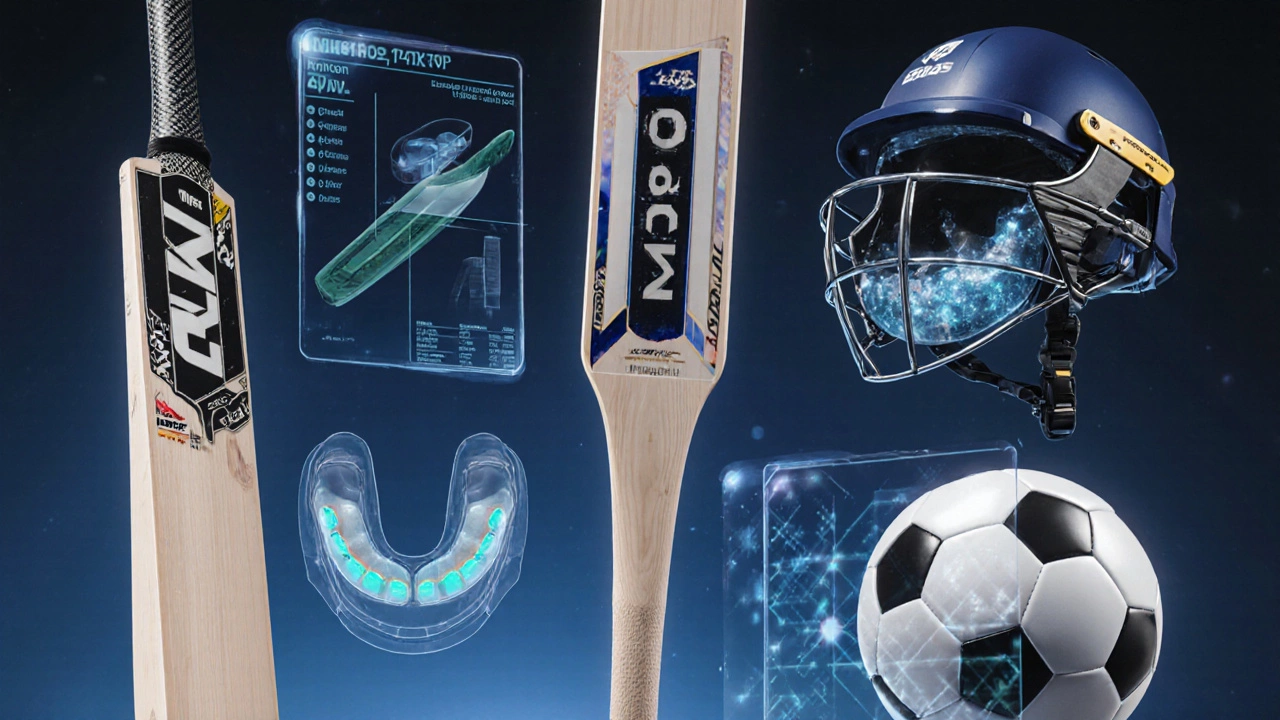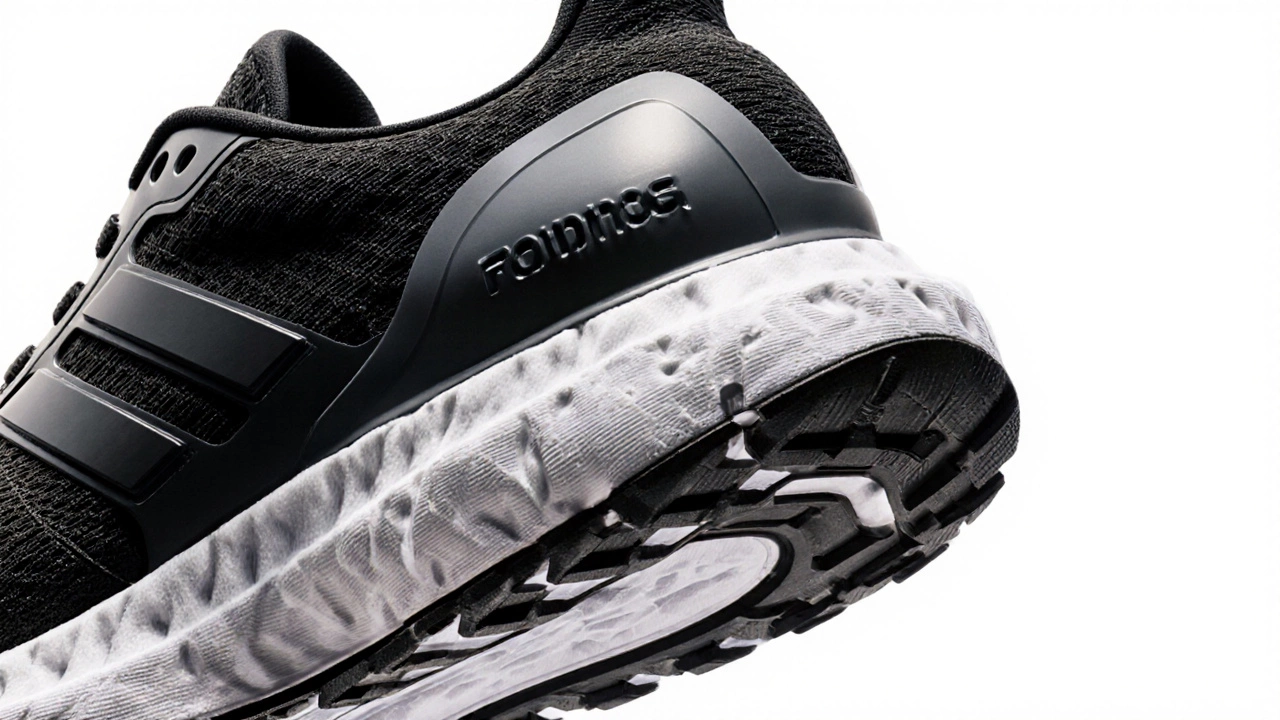Sports Equipment Selector
Choose Your Sport
When you grab a pair of running shoes, a tennis racket, or a soccer ball, you’re not just picking up gear-you’re holding a carefully engineered tool designed for one thing: helping your body perform better. Sports equipment isn’t just about brand logos or flashy colors. It’s built with specific physical, functional, and safety traits that make it work the way it should. Understanding these characteristics helps you choose the right gear, avoid injury, and get the most out of your training or game.
Material Composition Determines Performance
The materials used in sports equipment aren’t chosen by accident. They’re selected based on what the sport demands. A cricket bat, for example, is made from willow wood because it’s lightweight, has natural shock absorption, and allows for precise ball control. Modern hockey sticks, on the other hand, are made from carbon fiber composites-strong, stiff, and responsive. These materials affect everything from speed to durability.
Running shoes use EVA foam in the midsole because it’s soft enough to cushion impact but firm enough to return energy. High-end models add Pebax or TPU for even better rebound. A basketball’s outer layer isn’t just rubber-it’s composite leather or premium rubber with micro-grooves for grip, especially in sweaty conditions. The material directly impacts how the ball feels in your hands and how it bounces off the court.
Weight and Balance Are Critical
Weight might seem simple, but it’s one of the most overlooked factors in equipment design. A baseball bat that’s too heavy slows your swing, reducing power and reaction time. Too light, and you lose control and feel. The sweet spot isn’t just where the ball hits best-it’s where the weight distribution feels natural.
Tennis rackets are measured by swing weight, not just total weight. A head-heavy racket gives more power on groundstrokes but can tire your arm faster. A head-light racket offers better maneuverability for volleys. Professional players often customize the balance by adding lead tape to the frame. Even a 5-gram shift can change how the racket plays.
Even something as small as a golf club’s grip matters. A grip that’s too thick or too thin changes your wrist action, affecting shot accuracy. The right balance makes the equipment feel like an extension of your body.
Shape and Ergonomics Fit the Human Body
Sports equipment is shaped around how the human body moves. A hockey stick’s curve isn’t just for show-it’s designed to control the puck at high speeds and allow for accurate wrist shots. The curve depth and angle are regulated in professional leagues because they directly affect play.
Running shoes have a heel-to-toe drop-the difference in height between the heel and forefoot. Most standard models have an 8-12mm drop, but minimalist shoes drop to 0-4mm. This changes how your foot strikes the ground and which muscles you use. Runners with Achilles issues often switch to higher drops for reduced strain.
Boxing gloves aren’t just padded. They’re contoured to fit the natural shape of a clenched fist, with thumb placement designed to prevent hyperextension. The padding density varies: sparring gloves are softer for safety, while competition gloves are firmer for impact transfer. The shape isn’t optional-it’s a safety feature.

Flexibility and Responsiveness Matter
Some gear needs to be stiff. Others need to bend. A pole vault pole is a perfect example. It’s made of fiberglass and carbon fiber in specific ratios to store energy as it bends and then release it explosively. Too stiff, and you can’t clear the bar. Too flexible, and you lose control.
Similarly, a lacrosse stick’s shaft and pocket work together. The shaft needs to be rigid enough to pass and shoot, but the pocket-made of nylon mesh-must flex slightly to cradle the ball. The tension in the mesh affects how the ball releases. Players adjust it based on their position: attackers want a tighter pocket for control, defenders want a looser one for quick clears.
Even swimwear has flexibility built in. High-performance suits use woven polyurethane panels that compress muscles without restricting motion. They’re designed to reduce drag and support posture, not just look sleek.
Safety Features Are Non-Negotiable
Safety isn’t an add-on-it’s built into the core of every piece of sports equipment. Helmets in football, hockey, and cycling don’t just have foam padding. They’re multi-layered with shock-absorbing liners, hard outer shells, and chin straps designed to stay secure under impact. The MIPS system in many modern helmets adds a low-friction layer that reduces rotational forces during angled impacts, which studies show can lower concussion risk.
Shin guards in soccer aren’t just plastic shells. They’re tested to withstand impacts of over 200 joules-the equivalent of a 10kg weight dropped from 2 meters. They’re also shaped to cover the tibia without restricting movement. Poorly designed guards can cause more harm than none at all.
Even mouthguards have evolved. Custom-fitted ones aren’t just for show-they’re molded to your teeth and jaw, reducing the chance of jaw fractures and improving breathing during intense activity. The NFL requires all players to wear them, not because they’re trendy, but because data shows they reduce injury rates by 30%.

Consistency and Standardization Enable Fair Play
Every sport has governing bodies that set strict standards. FIFA regulates the size, weight, and pressure of soccer balls. A regulation ball must weigh between 410-450 grams and be inflated to 0.6-1.1 atmospheres. Too light, and it flies unpredictably. Too heavy, and it’s dangerous.
In tennis, the ITF tests balls for bounce height, deformation, and durability. A ball dropped from 100 inches must bounce between 53-58 inches. If it doesn’t meet that, it’s rejected. That’s why you see the same balls used in tournaments-they’re tested to perform identically across courts.
Even the color matters. A yellow tennis ball was adopted because it’s easier to see on TV and on grass courts. A white cricket ball is used in day games for visibility, while a red one is used in traditional tests. These aren’t aesthetic choices-they’re performance requirements.
Longevity and Maintenance Requirements Vary
Not all sports equipment lasts the same. A pair of running shoes typically lasts 500-800 kilometers. After that, the midsole foam breaks down, losing its cushioning. You won’t always feel it, but your joints will. Replacing them before they’re worn out is one of the smartest things a runner can do.
On the other hand, a well-maintained cricket bat can last years. It needs oiling every few months to prevent cracking and knocking in before first use to compress the wood fibers. A hockey stick might crack after a season of hard play, but a high-end model with carbon fiber can last two or three seasons if stored properly and not left in extreme heat.
Equipment that’s not maintained fails faster-and sometimes dangerously. A climbing rope with frayed sheathing can snap under load. A bicycle chain that’s not cleaned and lubricated wears out the cassette and chainrings, costing more in the long run. Knowing how to care for your gear is part of understanding its characteristics.
Technology Is Changing the Game
Sports equipment today isn’t just mechanical-it’s smart. Sensors in basketballs track spin rate and release angle. Smart soccer balls measure kick velocity and trajectory. Wearable tech embedded in jerseys monitors heart rate, muscle activation, and fatigue levels.
These aren’t gimmicks. They’re tools for improvement. Coaches use the data to adjust training. Athletes use it to fine-tune technique. Even recreational players benefit: a smart racket can tell you if you’re hitting the ball too high or low on the strings, helping you improve your form.
But technology doesn’t replace the core characteristics. It enhances them. A smart ball still needs the right weight, bounce, and grip. The sensors are just layers on top of the foundational design.
At the end of the day, sports equipment is the bridge between human effort and athletic achievement. It’s not magic. It’s science. Every stitch, curve, material choice, and weight adjustment is there for a reason. Whether you’re a weekend warrior or a professional, knowing what makes gear work helps you choose better, train smarter, and stay safe.
What are the most important characteristics of sports equipment?
The most important characteristics are material composition, weight and balance, shape and ergonomics, flexibility and responsiveness, safety features, and adherence to standardization rules. These factors determine how well the equipment performs, how safe it is, and how long it lasts. A good piece of gear balances all these traits for the specific sport.
Why does equipment weight matter so much?
Weight affects speed, control, and fatigue. A heavier racket gives more power but slows your swing. A lighter shoe lets you run faster but may not offer enough support. The key is balance-how the weight is distributed. A well-balanced piece feels natural in your hands or on your feet, reducing strain and improving performance.
Can poor equipment cause injuries?
Absolutely. Worn-out running shoes can lead to plantar fasciitis. A helmet that doesn’t fit properly increases concussion risk. Shin guards that are too thin won’t protect your tibia. Even a grip that’s too small can cause tennis elbow. Equipment isn’t just about performance-it’s your first line of defense against injury.
How do I know if my sports gear is outdated?
Look for signs like cracked soles, flattened cushioning, loose stitching, or reduced responsiveness. Running shoes lose bounce after 500-800 km. Tennis strings go dead after 20-40 hours of play. Golf clubs can lose their loft if the face wears down. If you notice a drop in performance or comfort, it’s likely time for a replacement.
Are expensive sports items always better?
Not necessarily. High price often reflects brand, marketing, or minor tech upgrades-not always better performance. A $200 running shoe isn’t always better than a $100 one if both have the same cushioning, drop, and support for your foot type. Focus on fit, function, and how it matches your sport and body-not the sticker price.
